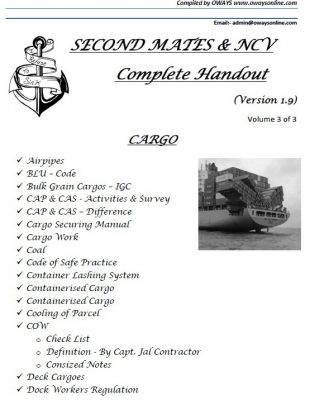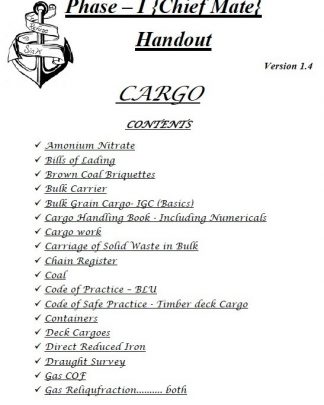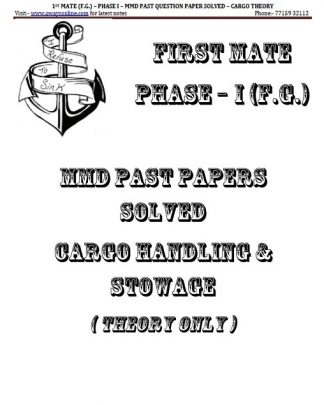Steps to be taken as per Timber Code prior to Loading & during Timber Deck Cargo:
Prior to loading:
- A pre-stow plan should be made carefully after considering all the available information (w.r.t. to the hold dimensions, cargo gear limitations & cargo dimensions), to allow the maximum utilization of the available space; the better the under-deck stowage, the more cargo can safely be carried on deck.
- The cargo spaces and related equipment should be examined to check for damages & repairs effected in an appropriate manner.
- The bilge suction screens should be examined to ensure they are clean, effective and properly maintained to prevent the admission of debris into the bilge piping system.
- The bilge wells should be free of extraneous material such as wood bark and wood splinters.
- Side sparring, pipe guards, etc., designed to protect internal hull members should be in place.
- The Master should ensure that the opening and closing of any high ballast dump valves (TST o’board v/vs) are properly logged. The Master should ensure that the dump valves are properly monitored to preclude (prevent) the accidental readmission of water into these tanks. Leaving these tanks open to the sea, could lead to an apparently inexplicable list, a shift of deck cargo, and potential capsize.
During Loading Operations:
- Each lift of logs should be hoisted aboard the ship in close proximity to the ship to minimize any potential swinging of the lift.
- The possibility of damage to the ship and the safety of those who work in the cargo spaces should be considered. The logs should not be swinging when lowered into the space. The hatch coaming should be used, as necessary, to eliminate any swinging of the logs by gently resting the load against the inside of the coaming, or on it, prior to loading.
- The logs should be stowed compactly, thereby eliminating as many voids as is practicable. The heaviest logs should be loaded first into the cargo spaces.
- Logs should generally be stowed compactly in a fore and aft direction, any remaining void spaces should be filled with logs stowed athwartships so as to fill in the void across the breadth of the space as completely as the length of the logs permits.
- Athwartship voids should be filled tier by tier as loading progresses.
- Extreme pyramiding of logs should be avoided to the greatest extent possible.
- If the breadth of the space is greater than the breadth of the hatch opening, pyramiding may be avoided by sliding fore and aft loaded logs into the ends of the port and starboard space.
- This sliding of logs into the ends of the port and starboard side of the space should commence early in the loading process (after reaching a height of approximately 2 m above the inner bottom) and should continue throughout the loading process.
- A careful watch by ship’s personnel should be maintained throughout the loading to ensure no structural damage occurs. Any damage which affects the seaworthiness of the ship should be repaired.
- When the logs are stowed to a height of about 1 m below the forward or aft athwartship hatch coaming, the size of the lift of logs should be reduced to facilitate stowing of the remaining area and logs in the hatch coaming area should be stowed as compactly as possible to maximum capacity.
After Loading:-
The ship should be thoroughly examined to ascertain its structural condition. Bilges should be sounded to verify the ship’s watertight integrity.
During the Voyage:
- The ship’s heeling angle and rolling period should be checked, in a seaway, on a regular basis. Wedges, wastes, hammers and portable pump, if provided, should be stored in an easily accessible place.
- The Master or a responsible officer should ensure that it is safe to enter an enclosed space by:
- Ensuring that the space has been thoroughly ventilated by natural or mechanical means, testing the atmosphere of the space at different levels for oxygen deficiency and harmful vapour where suitable instruments are available.
- Requiring self-contained breathing apparatus to be worn by all persons entering the space where there is any doubt as to the adequacy of ventilation or testing before entry.
Special Requirements For Ships Assigned Timber Freeboards:-
Construction of Ship
Superstructure
(1) Ships shall have a forecastle of at least standard height and a length of at least 0.07 L. In addition, if the ship is less than 100 metres (328 feet) in length, a poop of at least standard height, or a raised quarter-deck with either a deckhouse or a strong steel hood of at least the same total height shall be fitted aft.
Double Bottom Tanks
(2) Double bottom tanks where fitted within the midship half-length of the ship shall have adequate watertight longitudinal subdivision.
Bulwarks
(3) The ship shall be fitted either with permanent bulwarks at least 1 metre (391/2 inches) in height, specially stiffened on the upper edge and supported by strong bulwark stays attached to the deck and provided with necessary freeing ports, or with efficient rails of the same height and of specially strong construction.
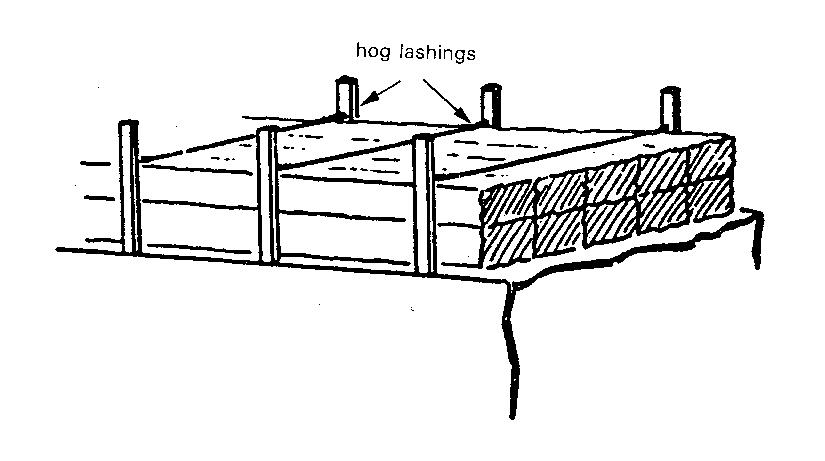
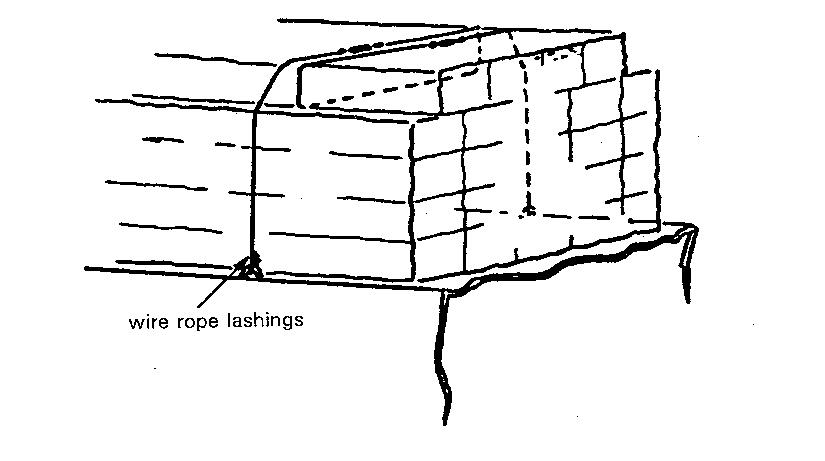

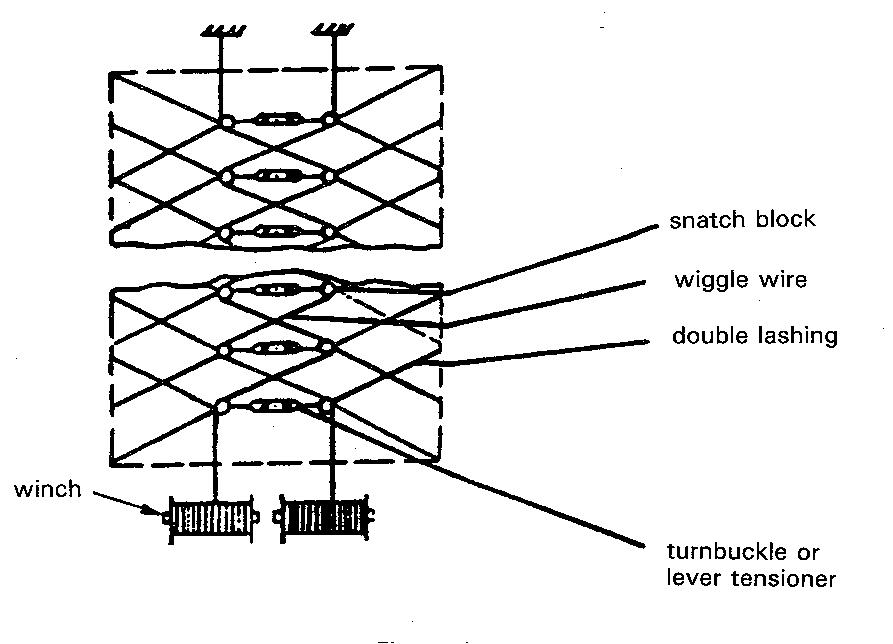
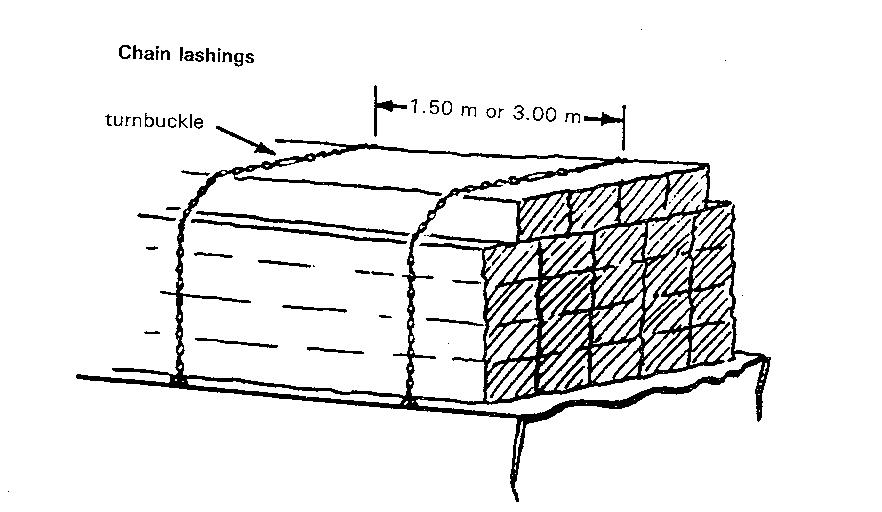
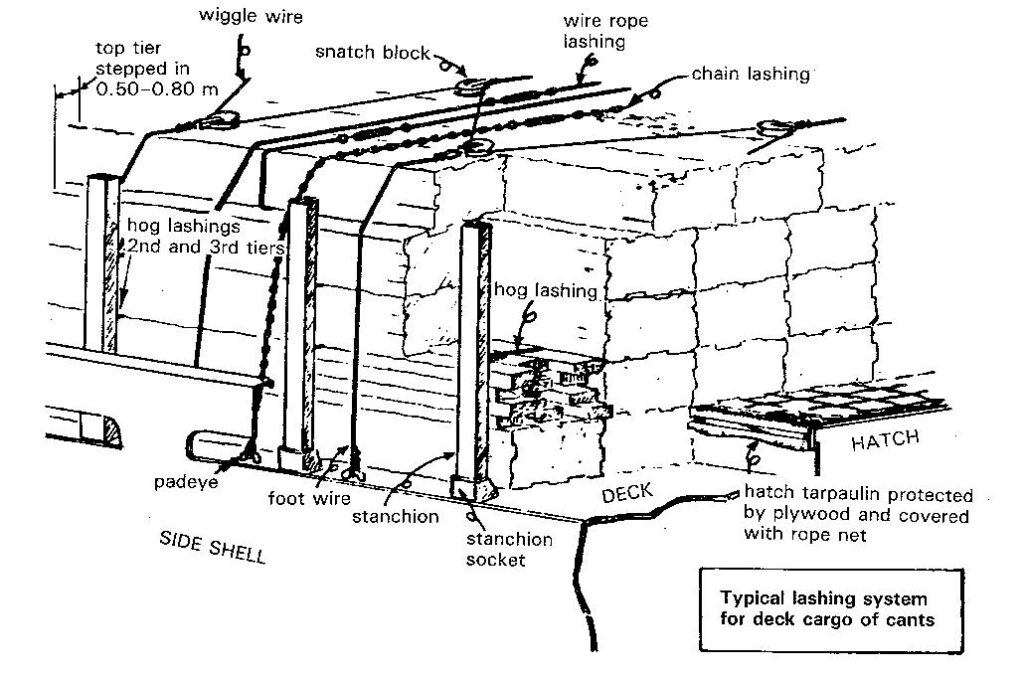
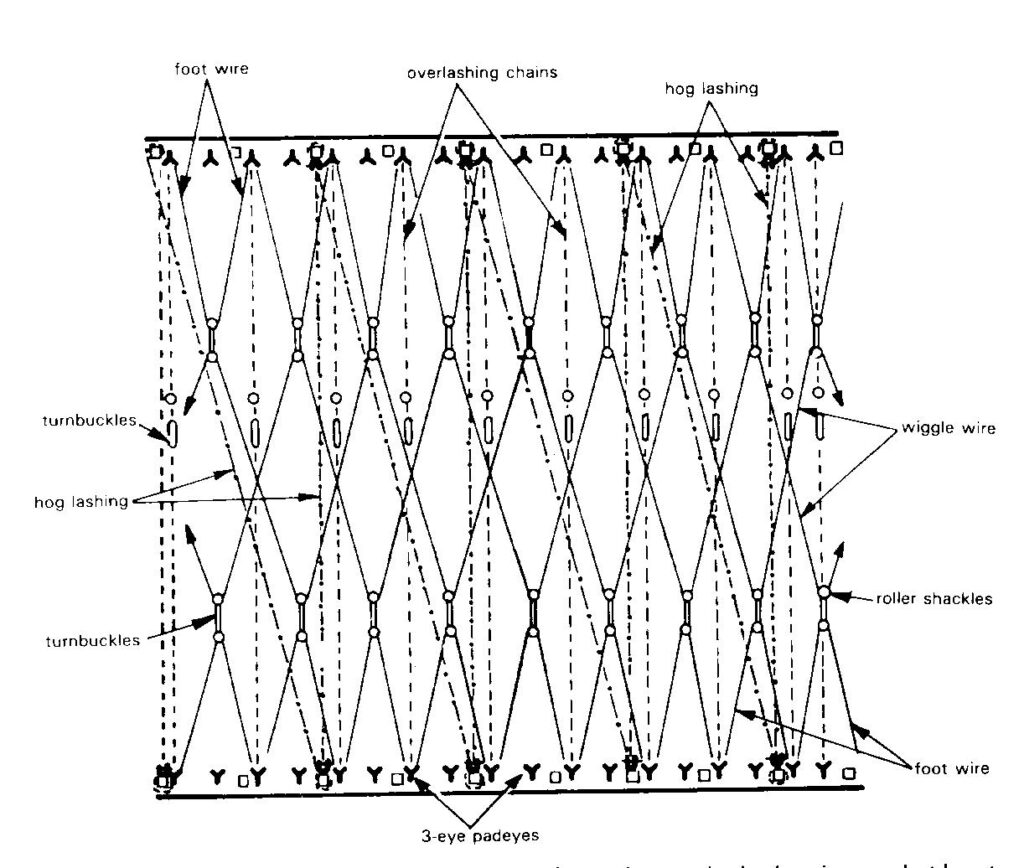
- Every lashing should pass over the timber deck cargo and be shackled to eyeplates suitable and adequate for the intended purpose and efficiently attached to the deck stringer plate. They should be in contact with the timber deck cargo throughout its full height.
- All lashings and components used for securing should possess a breaking strength of not less than 13.6 T;
- Every lashing should be provided with a tightening device or system so placed that it can safely and efficiently operate when required. There should be a provision of slipping/quick release arrangement in each lashing (to facilitate jettisoning of cargo if need arises).
- Upon completion and after the initial securing, the tightening device or system should be left with not less than half the threaded length of screw or of tightening capacity available for future use.
- Every lashing should be provided with a device or an installation to permit the length of the lashing to be adjusted. (wire lashings to have a short length of chain attached).
- The spacing of the lashings should be such that the two lashings at each end of each length of continuous deck stow are positioned as close as practicable to the extreme end of the timber deck cargo.
- If wire rope clips are used to make a joint in a wire lashing:
- They should be at least four in number, each spaced at intervals of not less than 15 cm.
- The saddle portion of the clip should be applied to the live load segment and the U-bolt to the dead or shortened end segment.
- They should be initially tightened so that they visibly penetrate into the wire rope and subsequently re-tightened after the lashing has been stressed.
- Greasing the threads of grips, clips, shackles and turnbuckles increases their holding capacity and prevents corrosion.
Shifting of timber deck cargo is due mainly to the following causes which may occur singly or together:
- Lashings becoming slack due to compaction of the cargo during the voyage, unsuitable devices for tightening the lashing system and/or inadequate strength of the lashings;
- Movement of the cargo across the hatch covers due to insufficient friction, particularly in ice and snow;
- Inadequate strength of the uprights due to poor material properties and/or excessive forces;
- Heavy rolling or pitching of the ship;
- Impact from heavy seas.
Personnel Protection and Safety Devices on Timber Ships:-
- Suitable protective clothing and equipment, such as studded boots or studded overshoes and hard hats, should be provided for the protection of crew members and workers involved in loading, securing or discharging operations.
- During the course of the voyage, if there is no convenient passage for the crew on or below the deck of the ship giving safe means of access from the accommodation to all parts used in necessary working of the ship, guard lines or rails, not more than 330 mm apart vertically, should be provided on each side of the deck cargo to a height of at least 1 m above the cargo. In addition, a lifeline, preferably wire rope, set up taut with a tightening device should be provided as near as practicable to the centreline of the ship. The stanchion supports to all guard rails or lifelines should be spaced so as to prevent undue sagging. Where the cargo is uneven, a safe walking surface of not less than 600 mm in width should be fitted over the cargo and effectively secured beneath, or adjacent to, the lifeline.
- Fencing or means closing should be provided for all openings in the stow such as at masthouses, winches, etc.
- Where uprights are not fitted or where alternatives to the provisions of subsection 5.2 are permitted, a walkway of substantial construction should be provided having an even walking surface and consisting of two fore and aft sets of guard lines or rails about 1 m apart, each having a minimum of three courses of guard lines or rails to a height of not less than 1 m above the walking surface. Such guard lines or rails should be supported by rigid stanchions spaced not more than 3 m apart and lines should be set up taut by tightening devices.
- As an alternative to 5.2, 5.3 and 5.3, a lifelines, preferably wire rope, may be erected above the timber deck cargo such that a crew member equipped with a fall protection system can hook onto and walk about the timber deck cargo. The lifeline should be:
- erected about 2 m above the timber deck cargo as near as practicable to the centreline of the ship;
- stretched sufficiently taut with a tightening device to support a fallen crew member without collapse or failure.
- Properly constructed ladders, steps or ramps fitted with guard lines or handrails should be provided from the top of the cargo to the deck, and in other cases where the cargo is stepped, in order to provide reasonable access.
- Personnel safety equipment referred to in this chapter should be kept in an easily accessible place.
Stowage and Securing of Cargoes as per Timber Code:
Stowage:-
The basic principle for the safe carriage of timber deck cargo is to make the stow as solid, compact and stable as practicable. The purpose of this is to:
prevent movement in the stow which could cause the lashings to slacken;
produce a binding effect within the stow; and
reduce to a minimum the permeability of the stow.
Openings in the deck exposed to weather over which cargo is stowed should be securely closed and battened down. The ventilators and air pipes should be effectively protected(19).
Deck cargo should be stowed so that access is provided to and from designated escape routes and spaces essential to operation of the vessel, such as machinery spaces and crew’s quarters, as well as to safety equipment, fire-fighting equipment and sounding pipes(18). It should not interfere in any way with the navigation and necessary work of the ship.
When cargo is loaded voids may occur in the stow between packages as well as between bulwarks or gantry crane rails, etc., and other fixed constructions such as the hatch coaming.
Care should be taken to avoid the creation of voids or open spaces when loading cargo. Voids, where created, should be filled with loose timber or blocked by vertical H-frames with required strength to avoid cargo shifting. The MSL for double H-frames of different widths and dimensions are given in the table below. The values apply to H-frames made of sound softwood timber without knots.
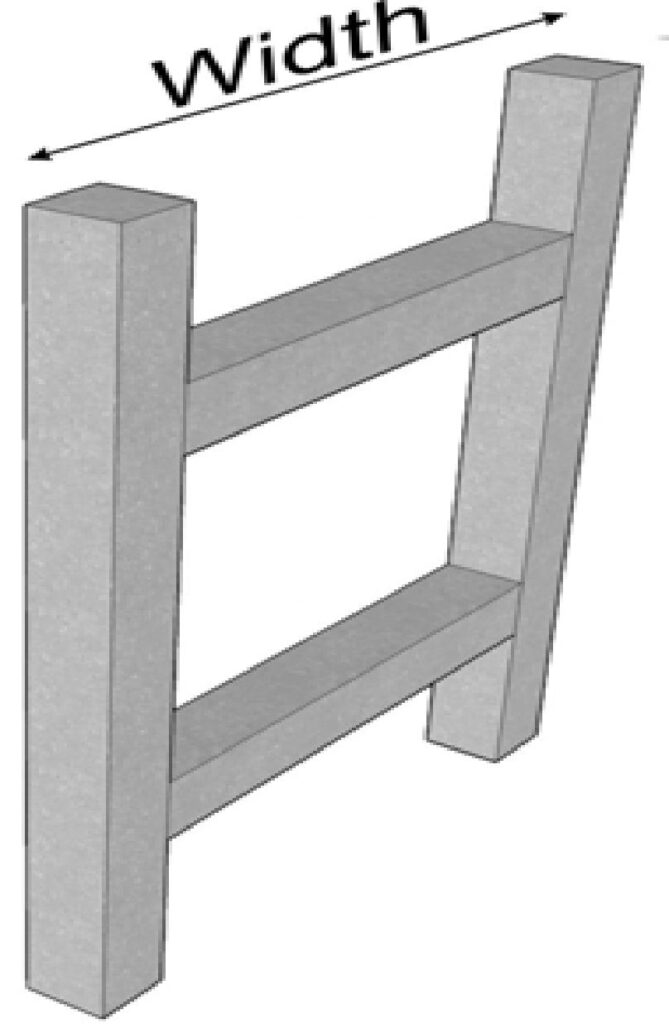
MSL (maximum secure load) of H-frames for different dimensions
| Dimensions of battens mm | MSL in kN of double H-frames with different widths | |||
| 0.5 m | 1.0 m | 1.5 m | 2.0 m | |
| 50 x 50 | 75 | 53 | 30 | 17 |
| 50 x 75 | 113 | 79 | 46 | 26 |
| 50 x 100 | 151 | 106 | 61 | 34 |
| 50 x 150 | 226 | 159 | 91 | 51 |
| 75 x 75 | 186 | 153 | 119 | 85 |
| 75 x 100 | 248 | 203 | 159 | 114 |
| 75 x 150 | 305 | 238 | 171 | |
| 75 x 200 | 317 | 227 | ||
| 100 x 100 | 301 | 256 | 212 |
- Timber deck cargo which substantially overhangs (one-third of the package length) hatch coamings or other structures in the longitudinal direction, should be supported at the outer end by other cargo stowed on deck or railing or equivalent structure of sufficient strength to support it.
- For ships assigned and making use of a timber load line, additional practices apply in accordance with the applicable Load Lines Convention(19).
Securing:-
- One or more of the following principal methods may be used to secure timber deck cargoes, by themselves or in combination with each other:
1) Different types of lashing arrangements.
2) Bottom blocking of the base tier in combination with lashing arrangements;
3) Blocking over the full height of the cargo by, e.g. uprights alternatively complemented by lashing arrangements;
4) Frictional securing, taking into account scientific research and appropriate weather and voyage criteria; and
5) Other practical securing enhancement, (taking into account appropriate weather and voyage criteria), such as:
a) non slip paints on hatch covers;
b) liberal use of dunnage in the stow to shore and bridge gaps;
c) double lashing in exposed areas; and .4 consideration given to the use of locking tiers.
- Securing arrangements used should be designed in accordance with Part B and documented in accordance with section 2.13 of this Code.
- Lashings:-
- Different lashing arrangements are described in Part B of this Code.
- The following three types of lashing equipment with different strength and elongation characteristics are most frequently used for securing timber deck cargoes. Individual suitability should be determined by such factors as ship type, size and area of operation, and as described in this Code and as prescribed in the cargo securing manual:
- chain lashings;
- wire lashings; and
- Fabricated web lashings.

- Open hooks, which may loosen if the lashing becomes slack, should not be used in securing arrangements for timber deck cargoes. Web lashing should not be used in combination with chain or wire lashing.
- The appropriate safety factors for the different types of equipment are described in Annex 13 to the Code of Safe Practice for Cargo Stowage and Securing (CSS Code).
- All lashing equipment should be visually examined according to the instruction in the cargo securing manual before use and only equipment fit for purpose should be used for securing of timber deck cargoes.
- The necessary pre-tension in the lashings used should be maintained throughout the voyage. It is of paramount importance that all lashings be carefully examined and tightened at the beginning of the voyage as the vibration and working of the ship will cause the cargo to settle and compact. They should be further examined at regular intervals during the voyage and tightened as necessary.
- Entries of all examinations and adjustments to lashings should be made in the ship’s logbook.
- Slip hooks or other appropriate methods may be used for quick and safe adjustment of lashings. Pelican hooks, when used, should be moused.
- Corner protectors should be used to prevent lashings from cutting into the cargo and to protect lashings from sharp corners. The latter especially applies to fabricated web lashings.
- Every lashing should be provided with a tightening device or system so placed that it can safely and efficiently operate when required.
